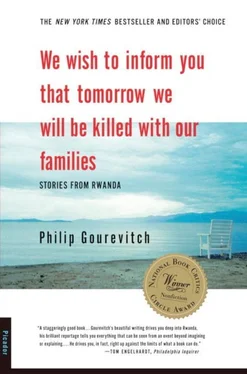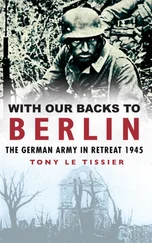In other words, a true genocide and true justice are incompatible. Rwanda’s new leaders were trying to see their way around this problem by describing the genocide as a crime committed by masterminds and slave bodies. Neither party could be regarded as innocent, but if the crime was political, and justice was to serve the political good, then the punishment had to draw a line between the criminal minds and the criminal bodies. “With those who masterminded the genocide, it’s clear-cut,” General Kagame told me. “They must face justice directly. I’m not as worried about these ordinary peasants who took machetes and cut people in pieces like animals.” He explained that “long ago” Rwandan justice was conducted in village hearings, where fines were the preferred penalties. “The guy who did the crime can give some salt or something, and that can bring the people back together,” Kagame said.
Salt for state-sponsored mass murder? Village justice, as Kagame sketched it, sounded hopelessly inadequate. But as the lawyer François Xavier Nkurunziza explained: “When you speak of justice with our peasants, the big idea is compensation. A cattle keeper or cultivator who loses his whole family has lost his whole economic support system. You can kill the man who committed genocide, but that’s not compensation—that’s only fear and anger. This is how our peasants think.” The problem, as Kagame suggested when he spoke of salt, was that after genocide compensation could, at best, be symbolic.
The government discussed easing the burden on the courts by ranking degrees of criminality among the génocidaires, and assigning lesser offenders to public works or reeducation programs. Politically, the RPF was more concerned with what in postwar Germany was called “denazification” than with holding every individual who had committed a crime during the genocide to account. “Actually, we’re trying to see how to get as many ordinary people off the hook as possible,” Gerald Gahima, an RPF political officer who was the Deputy Minister of Justice, explained. “But that’s not justice, is it? It’s not the justice the law provides for. It’s not the justice most people would want. It’s only the best justice we can try for under the circumstances.”
But if the guilty could never be fully punished and survivors could never be properly compensated, the RPF regarded forgiveness as equally impossible—unless, at the very least, the perpetrators of the genocide acknowledged that they had done wrong. With time, the quest for justice became, in large measure, a quest for repentance. Where ministers and parliamentarians had once preached the civic virtue of murdering one’s neighbors, members of the new government now traveled the countryside to spread the gospel of reconciliation through accountability.
Mass reburial ceremonies for genocide victims were a favorite forum for the new message. I attended such a reburial in the summer of 1995, on a hilltop amid the lush, mist-strewn tea plantations of Gisenyi. In this setting of astonishing tranquillity, the newly grown grass was pulled back to disclose a mass grave. The broken bodies within it were exhumed and laid out on a long rack. On the orders of village leaders, the local peasantry had come to see, and to smell the death smell, and President Bizimungu came with a half dozen cabinet ministers and many other officials. Soldiers distributed translucent plastic gloves among the villagers, and put them to work, placing pieces of the corpses in coffins and wrapping the rest in green plastic sheets. There were speeches and benedictions. A soldier explained to me that the President had used his speech to ask the peasantry where they had been when these dead were killed in their community, and exhorted them to make atonement. Then the dead were placed in new mass graves, and covered up again with earth.
WHEN RWANDANS SPOKE of reconstruction and reconciliation, they spoke of the need to overcome or to liberate themselves from “the old mentalities” of colonialism and dictatorship, and from the perfect pecking order of intimidation and obedience that had served as the engine of the genocide. The systems by which the old mentalities had been implanted had names—impunity, cronyism, ethnicity, feudalism, Hamitism—but the mentalities themselves lay deeper within each Rwandan, internalized in the reflexive habits of a lifetime’s experiences and expectations of brutality: us or them; kill or be killed. When Kagame said that people can be made bad, and can be taught to be good, he added, “There are mechanisms within society—education, a form of participation. Something can be achieved.” This view was widely shared, with varying degrees of certainty and skepticism, not only within the RPF but among many of the surviving anti-Habyarimana Hutu leaders, and—on a good day, at least—by much of the Rwandan public.
But where was Rwanda to turn for a model? The justice at Nuremberg was helpfully brought by foreign conquerors, and denazification in Germany was carried out in a context where the group that had been subjected to genocide would no longer be living side by side with the killers. In South Africa, armed struggle had ended, and the post-apartheid Truth Commission could presume that the country’s defeated white masters had accepted the legitimacy of the new order. Rwanda offered no such tidy arrangement. Guerrilla attacks from Hutu Power forces in Zaire escalated steadily throughout 1995, as did attacks on witnesses and survivors of the genocide. “Right now, if you were to give a general amnesty you would be inviting chaos,” said Charles Murigande, chairman of Rwanda’s Presidential Commission on Accountability for the Genocide. “But if we could put our hands on the leaders, even an amnesty would be very well received.”
That was a very big “if.” Just as Habyarimana’s death had made him a martyr for Hutu Power, it also ensured that the killing which was purportedly carried out in “defense” of his name had never carried a signal signature: a Hitler, a Pol Pot, a Stalin. The list of Rwanda’s “Most Wanted” was a hodgepodge of akazu members, military officers, journalists, politicians, businessmen, mayors, civil service functionaries, clerics, schoolteachers, taxi drivers, shopkeepers, and untitled hatchet men—dizzying to keep track of and impossible to rank in a precise hierarchy of command. Some were said to have given orders, loudly or quietly, and others to have transmitted or followed orders, but the plan and its execution had been ingeniously designed to look planless.
Still, Rwandan investigators were able to draw up a list of some four hundred top génocidaires —masterminds and master implementers. But all of them were in exile, beyond Rwanda’s reach. Almost immediately after its installation in 1994, the new government had appealed to the United Nations for help in apprehending fugitive Hutu Power leaders, so that they might stand trial before the nation. Instead, the UN created the International Criminal Tribunal for Rwanda, which was essentially a subset of the tribunal that had been established for the ugly Balkan war of the early 1990s. “We asked for help to catch these people who ran away and to try them properly in our own courts,” a Rwandan diplomat told me. “But the Security Council just started writing ‘Rwanda’ under the name ‘Yugoslavia’ everywhere.”
The Rwandan government regarded the UN’s decision to keep its resources to itself as an insult. The very existence of the UN court implied that the Rwandan judiciary was incapable of reaching just verdicts, and seemed to dismiss in advance any trials that Rwanda might hold as beneath international standards. “If the international community really wants to fight impunity in Rwanda, they should help Rwanda to punish these people,” Gerald Gahima told me at the Ministry of Justice. “It makes it harder to forgive the ordinary people if we don’t have the leaders here to be tried in Rwandan courts before the Rwandan people according to Rwandan law.” But the UN tribunal would not even sit in Rwanda, where the witnesses and concerned audience were; instead it was headquartered on “neutral territory,” in Arusha, Tanzania. “The tribunal,” Charles Murigande said, “was created essentially to appease the conscience of the international community, which has failed to live up to its conventions on genocide. It wants to look as if it is doing something, which is often worse than doing nothing at all.”
Читать дальше











